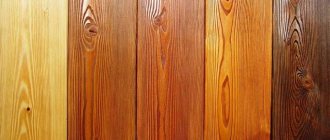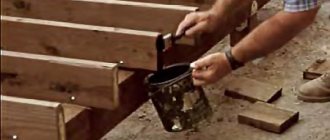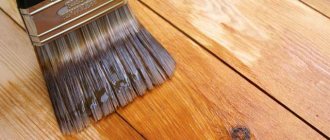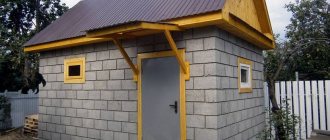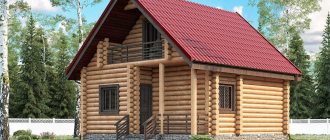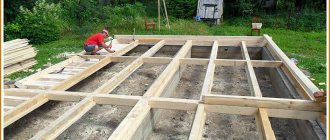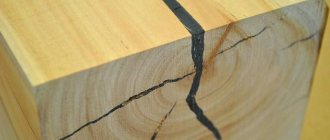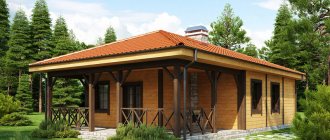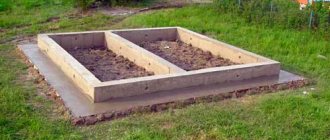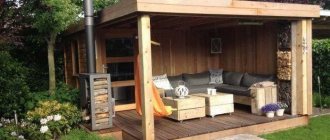If we are talking specifically about the processes of destruction of materials as a result of constant contact with liquids, then first of all we mean wood. It is this that is mainly used both in the construction and interior design of baths. The question “how to treat the floor in a bathhouse” is more than relevant, but before you understand the preparations and methods of protection against rotting and fungus, you need to clarify something.
Flooring (flooring, finishing coating) is a generalized concept. In relation to the bathhouse, they are not subject to treatment in all rooms. It is not recommended to impregnate, paint or otherwise protect wooden products, including floorboards, in a steam room. This room is characterized by extreme temperature values and temperature changes, which are quite sharp.
The use of even the most modern and advertised “chemistry” to protect floors from rotting in a steam room is fraught with the release of toxic substances (and they are contained to one degree or another in any preparation, no matter how much their manufacturers convince us otherwise).
Causes of wood rotting
Without special treatment, logs and floor boards begin to rot. Wood is an organic environment in which pathogenic microorganisms can develop very successfully. Most of them require two components:
- moisture;
- heat.
In a bathhouse, as a rule, wood is used to finish the floors, walls, ceiling, benches and shelves. That is why, without special treatment, logs and floor boards begin to rot. What are the main causes of rot in a room?
- poor waterproofing;
- lack of normal ventilation;
- high temperature and humidity;
- poor quality wood processing.
It is worth noting that certain wood species are more resistant to pathogens than others. For example, coniferous wood contains resins, which contain phytoncides.
Some wood species are more resistant to pathogens than others.
We recommend reading the Zen channel “zen.yandex.ru/vodakanazer.ru”, where you will find a lot of useful information for summer residents and gardeners.
This provides them with “immunity” against mold and mildew. For this reason, in order to prevent floor rotting, it is better to use the following types of wood:
- larch and fir;
- spruce and ash;
- cedar and pine.
The tree species most susceptible to moisture and, accordingly, pathogens are:
- maple and alder;
- aspen and linden;
- birch and elm.
Is it possible to protect wooden materials from rotting? To prevent the appearance of rot in the bathhouse, you can treat the wood with special impregnations and varnishes, which will be discussed further.
How to varnish a wooden floor?
Category: “Questions and answers”
Question No. 1. How to choose a color when painting the floor in a steam room?
Most manufacturers offer both clear varnishes and pigment paints. Ready-made mixtures or individual components are available on sale, for example, in multi-component paints. Most often, the floor in steam rooms is covered with transparent LKS. If desired, you can use any color. However, you should not choose bright shades. Since the steam room is a relaxation area, it is better to choose relaxing colors - blue, light yellow, pale green, beige.
Question No. 2. Is it possible not to paint the floor in the steam room?
This point of view has its supporters, who rightly argue that evaporation from any paint is inevitable. If you are not going to cover the floor in the steam room, be prepared to have to change it much more often. And the likelihood of rot, mold and blue stains increases significantly.
Question No. 3. What is better varnish or paint?
For aesthetic reasons, varnish is used more often because it is colorless, transparent or matte, and therefore highlights the texture of the wood well. Paint with colored pigments is used for decoration, in accordance with the overall styling of the interior. Whatever preference is given, the protective and safe qualities of paintwork materials should always come first.
Requirements for anti-putrefactive agents
The impregnation must necessarily include antiseptic components (phytoncides).
How to cover the floor in a bathhouse? The development of pathogenic flora in a “damp” room can be prevented with the help of special anti-rot compounds. Manufacturers of protective products produce various varnishes and impregnations, but not all of them have the necessary range of properties that would guarantee the absence of rot in the wood.
What properties should a high-quality impregnation have?
- Water repellent. It is water that makes wooden joists and boards vulnerable to pathogens. To prevent their development, the wood must be kept dry. To do this, use products that, after application, form a protective non-hygroscopic film on the surface of the floor and wall;
- Antiseptic. The composition of the impregnation must necessarily include antiseptic components (phytoncides). They prevent the proliferation of fungal spores and mold formation;
- "Repellent." Wood does not always suffer from rotting. Wood-boring insects can also cause damage to the coating. To prevent their appearance, you can use special formulations that contain insect repellent substances.
Chemical protection materials
It is important to choose the right treatment for wooden logs so that they last a long time. In private construction, self-made impregnations and ready-made compositions are used. Water-soluble antiseptics include liquids made on the basis of substances that are prescribed in SNiP, GOST and mixtures prepared according to folk recipes.
Impregnations with copper salts, linseed oil, urea, beeswax and wood resin solution are used for biological protection of bathhouse or house beams. Oil mixtures must be heated before use. Long-term service of wooden floor structures will be ensured by proper ventilation and impregnation. Experts say that when ventilation is working in the base of the bathhouse, dry wood logs do not rot.
Important points
Some of the volatile components in the composition of impregnations can cause real harm to health, so they cannot be used in a steam room.
If necessary, you can carry out disinfection in a bathhouse with your own hands. However, many experts do not recommend using synthetic compounds for these purposes. Why? The temperature in the sink and steam room is often very high. It provokes the evaporation of antiseptic components from the surface of the floor or wall that has been treated with it. Some of the volatile components can cause real harm to health.
To prevent the negative effects of anti-putrefactive agents on the body, the choice of protective compounds must be approached with care:
- In the rest room and dressing room, the air temperature, as a rule, does not exceed 27 degrees. They can be used without problems with synthetic compounds;
- In the sink and steam room both humidity and temperature are high. To eliminate the possibility of volatile substances entering the body, it is better to treat logs, floor boards and other wooden elements with organic-based compounds.
How to care for a painted steam room floor
The steam room is cleaned at least twice a month. In this case, it is advisable to adhere to the following sequence of work:
- Clean all vertical surfaces and benches from moisture, wiping thoroughly with a rag.
- Sweep the floor.
- Prepare a special solution of ammonia and water. It is important to maintain the proportion - for one liter of warm water - one tablespoon of ammonia (can be replaced with 9% vinegar).
- The wooden floor is washed like a deck, without lifting the mop they “draw” figure eights.
Types of anti-putrefactive agents
The fewest requirements are for compounds that will be used in the rest room and dressing room.
You can protect new wooden coverings from damage with your own hands if you purchase high-quality compounds. What types of funds can be used for these purposes?
- Lucky. Special varnishes contain antiseptic components that prevent the development of bacteria even in damp wood. They are used as a decorative finish, which at the same time prevents the materials from rotting;
- Impregnations. Impregnation is a colorless composition that contains phytoncides. These components protect joists and floor boards from the effects of biological agents - mold, bacteria, etc.;
- Antiseptics. Fungicide-based solutions are toxic. Therefore, they can be applied to walls, floors, joists and other wooden structures only if they are intended to be painted later.
The fewest requirements are for the compositions that will be used in the rest room and dressing room. In these moderately humid rooms, you can do disinfection yourself using impregnations both plant-based and synthetic-based.
Let's list the recommendations
Before construction starts
- To build a bathhouse, try to use wood cut in winter. In the fall you can lay the foundation, and in the spring you can install a bathhouse;
- Check the wood carefully. If you find characteristic signs, even if there is a healthy one nearby, do not take it. She is already affected and the appearance of spots is a matter of time;
If it is possible to use a moisture meter when choosing, great.
Under construction
- Be sure to provide “vents” for natural ventilation of the underground, attic and in the ribs of the frame;
- Properly arrange the waterproofing of the foundation and supporting structures (this also applies to vapor barriers);
- Provide effective exhaust ventilation;
- Treat the surfaces of the bathhouse with an antiseptic;
- Insulate freezing external walls, slopes and ceilings;
- If double-glazed windows are installed in the bathhouse windows, insert ventilation valves (for ventilation).
“There are three destroyers of the bathhouse empire - time, fire and mold. If everything is clear with the first two points, then many people don’t want to accept a fungal attack, but in vain...”
At the operational stage
- Promptly repair leaking plumbing fixtures and communications;
- Check the cleanliness of the ventilation ducts and the functionality of forced ventilation;
- If the bathhouse has the possibility of constant heating, provide it sufficiently;
- Try not to leave wet fabrics (towels, sheets, etc.) in an unheated bathhouse (for example, in a country house), and always straighten plastic shower screens (curtains) for complete drying;
Mold absolutely loves dirt. Therefore, wash the bathhouse regularly and thoroughly. Regular rinsing with water is not entirely effective. There are special household hygiene products for baths and saunas on sale. For example, Finnish cleaning solution HARVIA Sauna, Tolu and others. They are applied with a soft sponge and washed off with warm water.
Acrylic-based antiseptics
Acrylic products not only protect wood, but also give different shades.
Acrylic-based antiseptics help prevent the development of almost all types of pathogens. Before application, they are diluted with water, after which they are applied to walls, joists and floor boards. The distinctive features of such antiseptics include:
- Resistance to temperature fluctuations, which allows surface treatment not only in the rest room, but also in the washing room or steam room;
- Resistance to moisture, which helps prevent wood swelling, which subsequently leads to warping;
- High vapor permeability, thanks to which the wood can “breathe”.
If desired, this impregnation can be applied with your own hands. But before breeding and processing wooden surfaces, it is recommended to use protective glasses and gloves that will protect the skin and eyes from contact with the synthetic product.
How to paint bath floors: types of paints and which one is better to choose?
Drying oil for processing and floors
As a result of polymerization, drying oil forms a very durable protective film.
Drying oil is a film-forming composition that is made on a plant basis. Drying oil can be used to treat wooden coverings in the following rooms:
- washing;
- steam room;
- rest room;
- dressing room
As a result of polymerization, the liquid composition forms a very durable protective film that prevents moisture from entering the wood. Drying oil is used to treat coatings not only for disinfection, but also to prevent the appearance of splinters.
There are oil and natural drying oils. According to experts, it is more advisable to treat walls and floors in rooms where there is a significant increase in temperature with natural compounds that do not contain any synthetic ingredients.
Bathhouse projects
Number of projects 681
- 1 room
- 1 bathroom
Project of log bathhouse 4x6 m
- To favorites
- 60² Total area
- 6 x 4m Construction area
from 225,000 rub.
Construction time individually
- 1 room
- 2 bathrooms
Project Baths 5B-B
- To favorites
- 18.55² Total area
- 5 x 5m Building area
from RUB 300,159
Construction period 17 days
- 1 room
- 2 bathrooms
Project Baths Mercury
- To favorites
- 37² Total area
- 8 x 7m Construction area
from 499,500 rub.
Construction period 27 days
- 1 room
- 2 bathrooms
Bath Rafaella project
- To favorites
- 84² Total area
- 10 x 7m Construction area
from 1,134,000 rub.
Construction period 40 days
- 2 rooms
- 2 bathrooms
Project AS-2272
- To favorites
- 79² Total area
from 1,066,500 rub.
Construction time individually
Project of Log House Baths 4x5 m
- To favorites
- 20² Total area
- 4 x 5m Building area
from 245,000 rub.
Construction time individually
- 1 room
- 1 bathroom
Bani Anapa-5 project
- To favorites
- 30² Total area
- 6 x 6m Construction area
from 405,000 rub.
Construction time individually
- 1 room
- 1 bathroom
Antalya Baths Project
- To favorites
- 74.5² Total area
- 11 x 11m Construction area
from 1,005,750 rub.
Construction period 40 days
- 1 bathroom
Sanduny Baths-2 project
- To favorites
- 48² Total area
- 6 x 9m Construction area
from 587,012 rub.
Construction time individually
- 5 rooms
- 3 bathrooms
Bani Opus Project
- To favorites
- 159² Total area
- 13 x 10m Construction area
from 2,146,500 rub.
Construction time 82 days
Quad bathhouse project "Mega-2"
- To favorites
- 2 x 5m Building area
from 244,900 rub.
Construction time 1 day
- 1 room
- 1 bathroom
Bathhouse project No. 25-11
- To favorites
- 19.26² Total area
- 4 x 5m Building area
from 260,010 rub.
Construction time individually
- 1 room
- 2 bathrooms
Bathhouse project "Anthea"
- To favorites
- 43.2² Total area
- 8 x 7m Construction area
from 1,030,000 rub.
Construction time individually
- 1 room
- 1 bathroom
Bathhouse Ivanovo project
- To favorites
- 93² Total area
- 9 x 9m Construction area
from 1,255,500 rub.
Construction period 52 days
- 1 bathroom
Barrel sauna project 6m
- To favorites
- 13.2² Total area
- 6 x 2m Building area
from 259,000 rub.
Construction time individually
- 3 rooms
- 2 bathrooms
Bathhouse Parkhochevo project
- To favorites
- 146² Total area
- 9 x 12m Construction area
from 3,500,000 rub.
Construction time individually
- 1 room
- 1 bathroom
Project of a garden house-bath "Sanduny"
- To favorites
- 24.2² Total area
- 6 x 5m Construction area
from 326,700 rub.
Construction time individually
Project Hozblok made of timber “Light”
- To favorites
- 18² Total area
- 6 x 3m Building area
from RUB 143,550
Construction time 1 day
- 2 bathrooms
Bani South project
- To favorites
- 62² Total area
- 9 x 8m Construction area
from 994,000 rub.
Construction time individually
- 1 room
- 2 bathrooms
Bani Cricket 2 project
- To favorites
- 62.68² Total area
- 6 x 9m Construction area
from 846,180 rub.
Construction period 38 days
View all projects
There are many different means to protect finishing materials. Let's figure out how to treat the floor in a bathhouse from rotting and fungus, what requirements certain compositions must meet, and what the dependence is on the nature of the decorative flooring. We will also consider what can be used for the walls in the steam room and washing room, and what will be useful for the area near the stove. Read to the end and communication with consultants will take noticeably less time.
Assortment of protective compounds for baths Source bouw.ru
Mixed impregnations
Where is it better to use mixed impregnations? Mixed products are products that not only protect walls and floors from rotting, but also prevent fire. The washroom is a room with high humidity, so the likelihood of a fire in it is low. In the rest room, air humidity is approximately 60%, and in the dressing room - no more than 30%.
To provide high-quality protection not only from rotting, but also from fire, it is advisable to use mixed types of impregnations in the dressing room. As a rule, such products contain fire retardant reagents that do not pose a threat to health.
Useful video
Yes, it was surprisingly difficult to find a sane video. We stopped at this video because in it you will find references to compositions that were not found in our text - from the company TEKNOS. She is famous, she has facilities in Russia. Why not?
***
Finally, we would like to invite all of you to be more demanding customers, ask for the composition of the chemicals you are going to purchase and the certificates for it. Your health depends on this, so I would like to see real information, and not streamlined formulations.
Method of application of anti-putrefactive agents
Before applying the product, the surface of the wood must be sanded.
So that the floor in the sauna does not rot over time and is not subsequently subjected to biological attack, you need to use protective compounds. But to achieve the best effect, you need to know how to apply them correctly. What points should you pay attention to when treating floors with your own hands?
- Before using the product, you should read the instructions provided by the manufacturer on the packaging;
- Before applying impregnation to logs and other wooden coverings, their surface must be dried and, if possible, sanded;
- Regardless of whether the floor covering is processed in a sink or a rest room, it must be applied in several layers;
- Materials are processed at temperatures above 5-7 degrees.
If traces of rotting have already appeared on the surface of the wood, you cannot do without special chemical treatment of the room. For these purposes, aggressive antiseptic agents are used that kill pathogenic flora.
Traditional recipes for processing lag
Here are examples of folk recipes for how to treat bathhouse floor joists. The most common means is machine processing, used for preserving logs. A large number of recipes are based on a combination of oily waste, various salts and diesel fuel. According to the craftsmen, it will be enough to coat the beams only with oil. With this method you can stop wood rotting that has already begun.
This method is popular due to the existence of a large amount of used oil. Of course, the remedy is effective. The waste contains many active substances that suppress the reproduction of all biological organisms. Due to high chemical reactivity, joists should not be completely covered with used oil. This material cannot be used in a bathhouse. It is considered relatively safe to treat small areas of the most affected areas of timber: the ends and notches. These parts are the most accessible for harmful microorganisms to penetrate deep into the fibers.
To apply the polish, you need to heat it in a water bath, then use a brush to treat the prepared surface. The timber will be saturated with the molten emulsion better if it is not polished.
What to do to extend the life of a tree?
Impregnation for sauna
A difficult question for bathhouse owners (I think I came up with a new term). Many people do not want to subject their pleasant golden wood to treatment with synthetic materials. Why? They believe that this disturbs the microclimate (you know, heated boards “breathe”, release phytoncides, a natural aroma, and “chemistry” kills all this). By the way, our great-grandfathers did not bother about this at all. They simply re-laid the floors, and at the same time the walls.
Now times are different and special antiseptics for baths have appeared on the market, designed for exposure to high temperatures. If you believe manufacturing companies, such as the Finnish Tikkurila, they do not emit harmful fumes.
It’s probably worth giving up the prejudice that wood for a bath should not be treated with anything. In the end, we breathe in air that is far from the same as it was 200 years ago, and the food we eat is not at all purely organic, and now our forest does not grow outside our garden (although others do).
